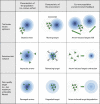Causes of maladaptation
- PMID: 31417611
- PMCID: PMC6691215
- DOI: 10.1111/eva.12844
Causes of maladaptation
Abstract
Evolutionary biologists tend to approach the study of the natural world within a framework of adaptation, inspired perhaps by the power of natural selection to produce fitness advantages that drive population persistence and biological diversity. In contrast, evolution has rarely been studied through the lens of adaptation's complement, maladaptation. This contrast is surprising because maladaptation is a prevalent feature of evolution: population trait values are rarely distributed optimally; local populations often have lower fitness than imported ones; populations decline; and local and global extinctions are common. Yet we lack a general framework for understanding maladaptation; for instance in terms of distribution, severity, and dynamics. Similar uncertainties apply to the causes of maladaptation. We suggest that incorporating maladaptation-based perspectives into evolutionary biology would facilitate better understanding of the natural world. Approaches within a maladaptation framework might be especially profitable in applied evolution contexts - where reductions in fitness are common. Toward advancing a more balanced study of evolution, here we present a conceptual framework describing causes of maladaptation. As the introductory article for a Special Feature on maladaptation, we also summarize the studies in this Issue, highlighting the causes of maladaptation in each study. We hope that our framework and the papers in this Special Issue will help catalyze the study of maladaptation in applied evolution, supporting greater understanding of evolutionary dynamics in our rapidly changing world.
Keywords: adaptation; fitness; global change; maladaptation.
Conflict of interest statement
None declared.
Figures



References
Publication types
Grants and funding
LinkOut - more resources
Full Text Sources
Other Literature Sources
Research Materials

